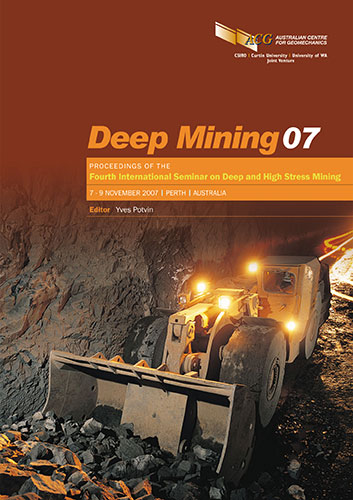Proactive Versus Reactive Seismic Monitoring in Mines - Results of a Seismic Monitoring Survey

|
Authors: Hudyma, MR; Heal, D |
DOI https://doi.org/10.36487/ACG_repo/711_14
Cite As:
Hudyma, MR & Heal, D 2007, 'Proactive Versus Reactive Seismic Monitoring in Mines - Results of a Seismic Monitoring Survey', in Y Potvin (ed.), Deep Mining 2007: Proceedings of the Fourth International Seminar on Deep and High Stress Mining, Australian Centre for Geomechanics, Perth, pp. 207-220, https://doi.org/10.36487/ACG_repo/711_14
Abstract:
A survey was undertaken to examine the use of seismic monitoring in mines. The 20-question survey titled “Application of Seismic Monitoring” (ASM) was used for rating the design and operation of seismic systems, and the application of seismic data. The survey indicated that the design, operation and data processing is relatively well conducted at most mines. However, data analysis and data interpretation are often not as well undertaken. Possible reasons for the lack of data analysis and data interpretation could be: lack of acceptance of mine seismology techniques, insufficient training, inadequate analysis tools, or lack of time to conduct the analyses. Mines that score well on the ASM survey tend to use their seismic systems proactively to understand the seismicity problem in their mines. Mines that score below average on the ASM survey tend to use seismic monitoring almost entirely as a reactive tool. The survey results for the 33 mines have been summarised to provide a means of benchmarking site practice against general practice in Australia and Canada.
References:
Amidzic, D. (2001) Energy-moment relation and its application. Proceedings Rockbursts and Seismicity in Mines –
RaSiM 5, Johannesburg, September 2001, G. van Aswegen, R.J. Durrheim and W.D. Ortlepp (eds),
Johannesburg, South African Institute of Mining and Metallurgy, pp. 509-513.
Brummer, R.K. (1999) Simple truths about rockbursts. Proceedings SARES99, 2nd South African Rock Engineering
Symposium, Johannesburg, 13-15 September 1999, T.O. Hagan (editor), 6-11. Johannesburg.
Cronbach, L.J. (1951). Coefficient alpha and the internal structure of tests. Psychometrika, Vol. 16(3), pp. 297-334.
Hudyma, M.R., Heal, D. and Mikula, P. (2003) Seismic monitoring in mines – old technology – new applications.
Proceedings 1st Australasian Ground Control in Mining Conference, Sydney, pp. 201-218.
Leslie, I. and Vezina, F. (2001) Seismic data analysis in underground mining operations using ESG’s Hyperion systems.
Proceedings 16th Quebec Mining Association Ground Control Colloque, March 2001, Val D'Or.
Mendecki, A.J., van Aswegen, G. and Mountfort, P. (1999) A guide to routine seismic monitoring in mines. Chapter 9
in A Handbook on Rock Engineering Practice for Tabular Hard Rock Mines. A.J. Jager and J.A. Ryder (eds),
Creda Communications, Cape Town.
Mikula, P.A. and Lee, M.F. (2002) Forecasting and controlling pillar instability at Mt Charlotte Mine. Proceedings 1st
International Seminar on Deep and High Stress Mining. Australian Centre for Geomechanics, Perth.
Proactive Versus Reactive Seismic Monitoring in Mines —
Results of a Seismic Monitoring Survey M.R. Hudyma, D. Heal
220 Deep Mining 07, Perth, Australia
© Copyright 2025, Australian Centre for Geomechanics (ACG), The University of Western Australia. All rights reserved.
View copyright/legal information
Please direct any queries or error reports to repository-acg@uwa.edu.au
View copyright/legal information
Please direct any queries or error reports to repository-acg@uwa.edu.au